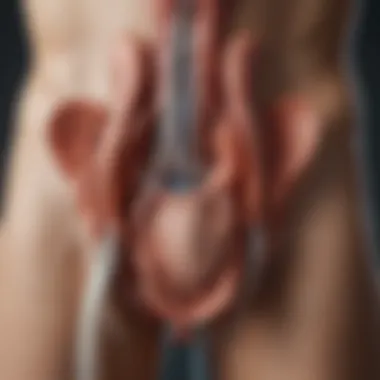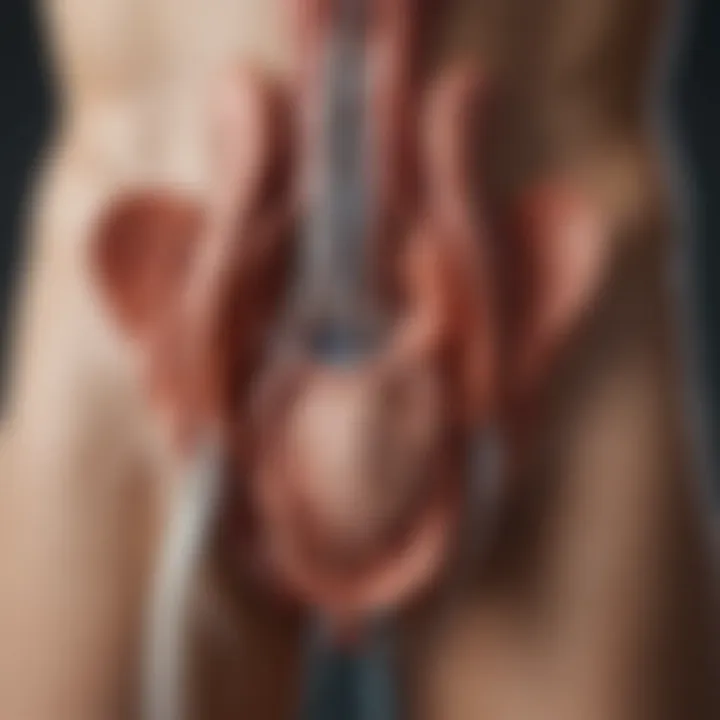Understanding Urine Drip: Causes and Management


Intro
Urine drip, often dismissed as a trivial issue, can profoundly impact one’s quality of life. Its implications are not limited to just discomfort; they extend to emotional and social domains. Understanding the underlying causes, potential health effects, and management strategies is essential. This comprehensive examination will bring clarity to individuals and health professionals navigating this often-embarrassing condition.
The significance of urine drip goes beyond the physical experience. Psychological factors like anxiety and embarrassment can exacerbate the symptoms. Awareness fosters compassion and constructive dialogue, influencing how we approach the condition. By dissecting the psychological, physiological, and lifestyle factors at play, this article offers well-rounded insights that are vital for anyone wishing to address or support those affected.
Key Benefits
Physical Health Benefits
Addressing urine drip can yield several physical health benefits, enhancing overall well-being. By understanding the various causes, individuals are better equipped to make health-conscious decisions. Maintaining a healthy weight can alleviate pressure on the bladder, thereby reducing symptoms. Moreover, hydration plays a significant role; proper fluid intake ensures that the urinary tract functions optimally. Here are several key physical benefits of managing urine drip:
- Improved bladder control
- Decreased risk of urinary tract infections
- Potential reductions in chronic pain associated with the condition
Mental Well-being Enhancements
The mental toll of urine drip is often underestimated. Individuals may encounter feelings of shame or social anxiety. Recognizing these effects is the first step toward better mental health. Implementing management strategies can lead to significant improvements in mood and confidence. Psychotherapy or professional counseling might be recommended for those struggling. This approach can promote healthier coping mechanisms. Consider these potential enhancements to mental well-being:
- Reduced anxiety in social situations
- Improved self-esteem and body image
- Enhanced overall emotional resilience
"Managing urine drip effectively not only alleviates physical discomfort but also restores dignity and agency to the individual."
Practical Tips
Effective Meal Planning
Nutrition plays a crucial role in managing urine drip. Certain foods can exacerbate symptoms, while others can improve bladder health. Here are some practical tips for effective meal planning:
- Incorporate fiber-rich foods: Whole grains, fruits, and vegetables can promote gastrointestinal health, indirectly benefiting bladder function.
- Limit irritants: Caffeine, alcohol, and spicy foods may trigger symptoms. Reducing or eliminating these can be beneficial.
- Hydration balance: Drinking enough water is important, but timing is key. Sipping water throughout the day rather than consuming large amounts at once can help maintain comfort.
Quick and Efficient Workouts
Physical activity can support overall health and contribute to bladder control. Exercise strengthens pelvic floor muscles, impacting urinary function positively. Here are some efficient workout suggestions:
- Kegel exercises: Target the pelvic floor muscles, enhancing control.
- Walking: A simple yet effective way to promote general health without straining.
- Yoga: Targets both physical and mental faculties, promoting relaxation and strength.
By adopting practical tips around meal planning and fitness routines, individuals can contribute to their own management strategies for urine drip. This dual approach helps in alleviating both physical symptoms and mental stress. Ultimately, a multifaceted understanding of urine drip leads to a more profound grasp of its effects and management.
Intro to Urine Drip
Urine drip is a significant health concern that can impact daily life for many individuals. Understanding this topic provides critical insights into its causes and effects, enabling targeted management strategies. This awareness helps individuals recognize symptoms early and seek assistance when necessary.
Defining Urine Drip
Urine drip, also known as urinary incontinence, refers to the involuntary leakage of urine. This condition can manifest in various forms, from minor leaks when sneezing or laughing to complete loss of control. Factors influencing urine drip include physical health, age, and even psychological status. Addressing urine drip requires a multi-faceted approach, as it often ties into broader health issues.
Prevalence and Demographics
Urine drip is more common than many think, affecting millions worldwide. It does not discriminate based on age or gender, though certain demographics are at higher risk. For example, women, especially after childbirth or during menopause, experience higher rates of urinary incontinence. According to studies, around 25% of adult women and 10% of men report experiencing some form of urine leakage. Understanding the demographics affected is crucial for health professionals in tailoring interventions.
- Women: Higher prevalence due to anatomical differences and life stages.
- Men: Often related to prostate issues.
- Older Adults: Age increases risk due to weakening of pelvic muscles.
"Recognizing the nuances of urine drip in different populations can lead to better prevention and management strategies."
Physiological Mechanisms of Urine Drip
Understanding the physiological mechanisms of urine drip is fundamental to grasping how it affects individuals. These mechanisms explain how the body regulates urination and what goes awry in cases of urine drip.
The Urinary System Overview
The urinary system plays a crucial role in maintaining the body's homeostasis. It consists of the kidneys, ureters, bladder, and urethra. The kidneys filter blood to produce urine, which is then transported to the bladder via the ureters. The bladder stores urine until it is excreted through the urethra during urination. Dysfunction in any component of this system can lead to urine leakage. Important functions include the following:
- Filtration: Removes waste from the blood.
- Storage: Holds urine until the body is ready for excretion.
- Control: The nervous system coordinates muscle contractions in the bladder and sphincters to prevent leakage.
Maintaining the integrity of these functions is vital for urinary control.
Factors Leading to Leakage
Several factors can lead to urine leakages, such as overactive bladder, pelvic floor dysfunction, neurological conditions, and the aging process.
Overactive Bladder
Overactive bladder (OAB) is characterized by an uncontrollable urge to urinate, often leading to frequent urination and potential leakage. This condition arises from involuntary contractions of the bladder muscles, compelling individuals to rush to the bathroom. Its key characteristic is the urgency, which can disrupt daily activities and sleep.
- Unique Feature: The condition can be both frustrating and embarrassing.
- Advantages: Early diagnosis can lead to effective management strategies, including behavioral therapies and medications.
However, OAB may significantly impact the quality of life due to these sudden urges, requiring tailored management approaches.
Pelvic Floor Dysfunction
Pelvic floor dysfunction refers to a range of problems where the pelvic muscles are too weak or too tight. This can lead to issues with bladder control, causing urine drip. A key characteristic is the muscle imbalance, which affects how well the bladder can hold urine.


- Unique Feature: Physical therapy can often improve muscle function.
- Advantages: Targeted exercises may help strengthen pelvic muscles, thus reducing symptoms.
This condition often necessitates a combination of physical therapy and potentially other interventions to restore balance and function.
Neurological Conditions
Neurological conditions such as multiple sclerosis or Parkinson's disease can contribute to urine drip by impacting the nerves that control bladder function. They can disrupt the communication between the bladder and the brain, leading to involuntary contractions or the inability to sense when the bladder is full.
- Unique Feature: Symptoms can vary widely based on the specific condition.
- Advantages: Understanding the link between the neurological condition and urine drip can lead to more appropriate treatments.
For individuals with these conditions, management often focuses on adapting treatment to both urinary issues and the underlying neurological disorder.
Aging Process
The aging process affects bodily functions, including those of the urinary system. Older adults may experience weakened bladder muscles or changes in nerve signals, resulting in a higher likelihood of leaks.
- Unique Feature: Aging is a natural process but can be accompanied by various health issues.
- Advantages: Older adults can significantly benefit from lifestyle modifications and targeted exercises to manage symptoms effectively.
Currently, the focus is on integrating preventive measures and management strategies that are suitable for aging populations to maintain urinary control.
Causes of Urine Drip
Understanding the causes of urine drip is crucial for managing this condition effectively. Identifying the underlying reasons can inform treatment decisions and improve patient outcomes. Knowledge of these causes assists both health professionals and patients in recognizing patterns and making lifestyle adjustments. Furthermore, differentiating between medical and lifestyle factors provides a two-pronged approach for tackling urine drip.
Medical Conditions
Urinary Tract Infections
Urinary tract infections (UTIs) are a significant contributor to urine drip. These infections can irritate the bladder lining, leading to increased urgency and frequency of urination. One key characteristic of UTIs is the sudden onset of these symptoms. This makes UTIs a critical focus for this article. Their unique feature lies in how they can rapidly worsen bladder function, making management essential. Failure to address UTIs may result in chronic urinary issues, which complicate treatment of urine drip.
Prostate Issues
Prostate problems, such as benign prostatic hyperplasia, can lead to urine drip in men. The enlarged prostate can compress the urethra, obstructing the flow of urine. This leads to incomplete bladder emptying, which is a common aspect of this condition. Recognizing prostate issues is important because it allows for targeted interventions. The unique feature of prostate-related urine drip is that it is often both progressive and age-related. Untreated, this can significantly impact quality of life.
Diabetes
Diabetes is another medical condition directly correlated with urine drip. High blood sugar levels can result in increased urine production. A significant aspect of diabetes is the risk of nerve damage that affects bladder control. This makes diabetes a vital inclusion in this discussion. The unique challenge posed by diabetes related urine drip is dual; managing blood sugar while also addressing urinary symptoms. This complexity makes it imperative for patients and healthcare providers to collaborate effectively in management strategies.
Lifestyle Factors
Fluid Intake Patterns
Fluid intake patterns play a pivotal role in urine drip management. Over or under-hydrating can lead to inconsistent bladder function. A key characteristic of fluid intake is its direct relation to urinary frequency and urgency. This discussion is critical for practical approaches to manage urine drip. Understanding the unique aspects of fluid intake can help individuals tailor their hydration habits to better suit their needs. This not only affects urine drip but overall health as well.
Excessive Caffeine Consumption
Excessive caffeine consumption is often overlooked but significantly impacts urine drip. Caffeine acts as a diuretic, increasing urine production. A key takeaway is that it can exacerbate symptoms of urgency and frequency. This makes it an important factor to consider in lifestyle modifications. The unique aspect of caffeine-related urine drip is that the effects can vary greatly among individuals, necessitating careful monitoring and adjustment of intake.
Obesity
Obesity affects urine drip through increased abdominal pressure and weakened pelvic support. A crucial aspect of obesity is its association with various health issues, which can further complicate bladder management. Its consideration in this article is important because addressing weight can yield significant improvements in bladder function. The unique feature of obesity-associated urine drip is that weight loss can often result in symptom improvement, making it a rewarding target for intervention.
Understanding these causes, both medical conditions and lifestyle factors, equips individuals and health professionals to develop effective, personalized management strategies. The interplay of these elements emphasizes the importance of a multi-faceted approach that includes both medical treatment and lifestyle modification.
Psychological Aspects of Urine Drip
The psychological dimensions related to urine drip play a vital role in understanding this condition. Recognizing how mental health interacts with bodily functions can deepen our approach to management and care. Often, individuals with urine drip experience feelings of embarrassment or anxiety, which can exacerbate their situation. This aspect is rarely discussed, yet it carries significant implications for treatment outcomes. Addressing psychological aspects can lead to better overall management and improved quality of life.
Social Stigma and Mental Health
Urine drip is often shrouded in social stigma, leading many individuals to feel isolated. This stigma can stem from societal perceptions of urinary incontinence as a sign of weakness or a lack of control. Consequently, those affected might avoid seeking help. The impact of such stigma can manifest as increased anxiety and depression. It is crucial for healthcare providers to foster environments that encourage open dialogues about urine drip, validating patients' experiences and emotions. By reducing stigma, we can improve mental health outcomes and promote proactive management.
Coping Mechanisms
Coping mechanisms are essential for individuals dealing with urine drip. They can significantly influence how one handles the challenges posed by this condition.
Behavioral Strategies
Behavioral strategies encompass a wide range of approaches aimed at managing symptoms effectively. These may include bladder training exercises or scheduled toileting. A key characteristic of behavioral strategies is their adaptability; these techniques can often be tailored to fit individual lifestyles and needs. This personal touch makes them a popular choice among many health professionals.
The unique feature of behavioral strategies lies in their proactive nature. By actively engaging in these methods, individuals can regain a sense of control over their condition. This empowerment often leads to improved self-esteem and reduced stigma. However, it is important to note that behavioral strategies may require time and consistency for noticeable results. The commitment to these techniques can sometimes be challenging, but the potential benefits are considerable.
Support Systems
Support systems refer to the networks of people, including friends, family, and healthcare providers, who offer emotional and practical assistance. A fundamental aspect of support systems is their role in providing validation and understanding. This can be especially beneficial for individuals who feel isolated by the stigma surrounding urine drip. When individuals have a reliable support system, they are more likely to seek help and stay committed to their management plans.
The unique feature of support systems is their diversity. They can include both formal arrangements, such as counseling or support groups, and informal networks, such as friends or family. Each type of support can offer different advantages. For instance, professional support groups can provide expert advice and shared experiences, while friends and family can offer emotional comfort and encouragement. However, reliance on informal support may vary and might not always provide the structured guidance needed.
Diagnosis of Urine Drip
Diagnosing urine drip is a crucial step in understanding the condition and its management. An accurate diagnosis helps health professionals identify the underlying causes of urine leakage and tailor treatment plans accordingly. Understanding the specifics of how urine drip manifests allows for more effective management strategies. Furthermore, an early and clear diagnosis can significantly improve patient outcomes and quality of life. As such, this section focuses on the initial assessment and various diagnostic tests that are integral in discerning the factors contributing to urine drip.
Initial Assessment


The initial assessment serves as the foundation for diagnosis. It usually starts with a comprehensive review of the patient's medical history. Health professionals ask about symptoms, associated factors, and quality of life impacts. This information helps establish the context within which urine drip is occurring. For example, questioning should include details on frequency, volume of leakage, and any potential triggers like physical activities or emotional stress. Also, a physical examination may be part of the initial assessment to check for any anatomical abnormalities. This thorough approach is essential for recognizing the multifactorial nature of urine drip.
Diagnostic Tests
Diagnostic tests play an essential role in confirming the initial assessment. They help substantiate the clinician's observations and aid in categorizing the type of urine drip, whether it is stress, urge, or overflow incontinence. Different tests provide various insights, and reliance on multiple testing modalities increases the accuracy of the diagnosis.
Urinalysis
Urinalysis involves examining urine samples for abnormalities. It helps in identifying infections, blood, and other markers that could indicate underlying conditions. One key characteristic of urinalysis is its non-invasive nature, making it a popular choice. This test is often the first step to rule out infections that can exacerbate symptoms of urine drip.
Urinalysis also has unique features such as the ability to detect changes in urine composition. However, while it is helpful, it might not reveal specific issues related to urinary function, which is a limitation in diagnosing urine drip directly.
Ultrasound Imaging
Ultrasound imaging is another important diagnostic tool. This method provides a visual assessment of the urinary structures, such as the bladder and kidneys. A key characteristic of ultrasound is its safety and non-invasiveness, allowing it to be used for various patient demographics.
One significant advantage of ultrasound imaging is its ability to identify anatomical issues, such as obstructions or bladder abnormalities. However, it may not provide functional information on how the bladder stores and releases urine, which means it often complements other tests rather than stands alone.
Urodynamic Testing
Urodynamic testing examines how well the bladder and urethra function. This comprehensive evaluation measures bladder pressure, capacity, and the flow of urine. A main characteristic of this test is its detailed nature, providing a deeper understanding of urinary function.
Urodynamic testing is beneficial as it quantifies various aspects of urine storage and release. The data obtained helps identify specific dysfunctions leading to urine drip. However, this test is more invasive than the others and can be uncomfortable for some patients, which might deter individuals from undergoing the procedure.
Accurate diagnosis of urine drip requires an amalgamation of initial assessments and several diagnostic tests, which collectively provide a holistic view of the patient's condition.
Overall, focusing on diagnosis allows health professionals to navigate the complexities surrounding urine drip effectively. This understanding ultimately fosters individualized treatment plans, catering to the unique needs of each patient.
Treatment Options for Urine Drip
The management of urine drip is crucial not only for enhancing the quality of life for individuals affected but also for mitigating potential health complications. In this article, we analyze various treatment options available, ranging from behavioral therapies to medications/ surgical procedures. Understanding these options aids health professionals in tailoring management strategies for their patients and empowers individuals to take control of their condition.
Behavioral Therapies
Bladder Training
Bladder training involves techniques to help patients regain control over their urination patterns. This method encourages individuals to gradually increase the time between bathroom visits, retraining the bladder to hold urine for longer periods.
The key characteristic of bladder training is its focus on consistency and awareness. Patients learn to recognize their triggers and consciously manage their urges. As a result, bladder training stands out as an effective and non-invasive option for urine drip.
A unique feature of this method is its adaptability. It can be combined with other behavioral strategies, such as pelvic floor exercises, to strengthen bladder control. However, continuous commitment is necessary for success, and it may take time to see significant improvements.
Fluid Management
Fluid management plays a vital role in controlling urine drip by strategically adjusting fluid intake. By maintaining an optimal balance, one can alleviate symptoms and avoid instances of leakage. The key characteristic of this approach is its simplicity. Individuals can tailor their fluid consumption to suit their daily activities and timelines.
The unique feature of fluid management is its empowerment. It encourages individuals to monitor their intake, which promotes responsibility over one’s health. However, excessive restriction of fluids may lead to dehydration or other complications, making a balanced approach critical.
Medications and Procedures
Anticholinergics
Anticholinergics are a class of medications commonly prescribed for their ability to reduce involuntary bladder contractions. This is particularly beneficial for individuals suffering from overactive bladder, a common contributor to urine drip. The key characteristic of anticholinergics is their effectiveness in providing rapid symptom relief.
A unique feature of these medications is their varied formulations. They can be administered in different ways, including oral tablets and transdermal patches, which offer flexibility for patients. However, potential side effects, such as dry mouth and constipation, may offset the benefits for some individuals.
Botox Injections
Botox injections have emerged as a novel therapeutic option for those with significant bladder dysfunction. These injections work by temporarily paralyzing the muscles responsible for bladder contractions, leading to reduced urgency and frequency. The key characteristic of this treatment is its targeted action, which can greatly enhance quality of life.
The unique feature of Botox is its long-lasting effects, often requiring re-treatment only every six to nine months. Yet, it's essential to acknowledge that not every patient may respond positively, and some might experience discomfort during the injection process.
Surgery
Surgical options are usually considered for individuals who do not respond to other treatments. Procedures range from minimally invasive techniques to more extensive surgeries, depending on the underlying cause of urine drip. The key characteristic of surgical intervention is its potential for permanent resolution of symptoms.
A unique feature of surgery is its ability to address anatomical issues, such as pelvic organ prolapse, directly. However, the decision for surgery should be made carefully due to inherent risks and the need for a longer recovery period post-operation.
Lifestyle Modifications and Management
Managing urine drip effectively incorporates various lifestyle modifications. These changes can play a crucial role in alleviating symptoms and improving overall quality of life. Understanding how dietary habits, physical activity, and other behavioral factors contribute to this condition is essential. Adopting tailored lifestyle changes provides an opportunity for individuals to take charge of their health and make informed decisions that resonate with their specific needs.
Dietary Changes
Reducing Irritants
Reducing irritants involves minimizing the consumption of substances that can trigger or worsen urine drip. Common irritants include caffeinated beverages, alcohol, and spicy foods. These substances can lead to bladder irritation, increasing urgency and frequency of urination, which exacerbates symptoms.
The key characteristic of reducing irritants is its immediate effect on bladder function. Making this dietary adjustment can lead to noticeable improvement in symptoms. This approach is beneficial as it provides a non-invasive way to manage the condition. One unique feature of reducing irritants is that it varies based on individual tolerance levels; what may irritate one person might not bother another.
However, there are disadvantages. Eliminating certain foods and drinks can lead to dietary restrictions, which may be challenging for some individuals. Careful attention to one’s own body response is necessary in this process.


Increasing Fiber Intake
Increasing fiber intake is another dietary change that can significantly influence urine drip management. A fiber-rich diet promotes healthy bowel function, which is particularly important for bladder health. When constipation occurs, it can place pressure on the bladder, leading to increased leakage. Incorporating foods high in fiber, like fruits, vegetables, and whole grains, can help mitigate this issue.
The key characteristic of increasing fiber is its ability to enhance overall digestive health. This adjustment is seen as beneficial and popular due to its simplicity and health benefits beyond managing urine drip. A unique feature of dietary fiber is its role in maintaining regular bowel movements, which directly impacts bladder pressure and function.
However, an increase in fiber intake requires a gradual approach, as sudden changes may lead to digestive discomfort, such as bloating or gas. Therefore, it is essential for individuals to monitor their fiber consumption closely.
Physical Activity and Exercise
Kegel Exercises
Kegel exercises are targeted workouts for the pelvic floor muscles. Regular practice of these exercises can improve muscle strength and control, which is crucial for those dealing with urine drip. They enhance the ability to control urination by strengthening the muscles involved in bladder control.
The key characteristic of Kegel exercises is their versatility; they can be performed discreetly and require no special equipment. This makes them a popular choice for management as they fit easily into one’s daily routine. The unique feature is that, with consistent practice, individuals may notice significant improvement in bladder control and reduced leakage over time.
On the downside, commitment and proper technique are essential for effectiveness. Many may struggle with consistency or misperform the exercises, reducing their benefits. Therefore, guidance from health professionals can be beneficial.
Low-Impact Activities
Low-impact activities, such as walking, swimming, and yoga, contribute positively to overall health, including aspects related to urine drip. These activities support adequate circulation and strengthen various muscle groups without putting excessive strain on the body. This is important as high-impact activities may exacerbate urine leak issues.
The key characteristic of low-impact activities is their accessibility and low risk of injury. This makes them a valuable consideration for individuals across different fitness levels. Their unique feature lies in promoting relaxation, reducing overall stress levels which can also influence bladder health positively.
However, the challenge is that low-impact activities might not yield immediate results in symptom reduction. Patience and a consistent routine are necessary for lasting benefits.
Incorporating lifestyle modifications not only helps in managing urine drip but also fosters a healthier overall lifestyle.
Monitoring and Follow-Up
Monitoring and follow-up are critical components in managing urine drip effectively. Regular assessment enables healthcare professionals to keep track of a patient's condition and the effectiveness of prescribed management strategies. Without consistent observation, it becomes challenging to determine if current interventions are beneficial or require adjustments. Patients might not always report changes in their condition immediately; thus, systematic monitoring can catch developments early.
Regular consultations with health professionals provide a platform for dialogue about the patient's experiences. These meetings can help clarify any concerns or questions regarding urine drip treatment. A close-knit support structure enhances compliance with treatment plans and motivates patients to make needed lifestyle changes.
Additionally, healthcare providers can educate patients about recognizing their symptoms and understanding when to seek further help. By fostering a proactive approach, monitoring minimizes complications over time, which can lead to better overall health outcomes.
Regular Consultations
Regular consultations are essential for managing urine drip. They facilitate communication between patients and healthcare providers. During these appointments, healthcare professionals can evaluate the patient's current condition, discuss any new symptoms, or explore the effectiveness of treatment plans. This iterative process ensures treatment is responsive to individual needs.
Moreover, these consultations create opportunities for healthcare teams to offer tailored advice. Adjusting treatment strategies based on patient feedback enriches the management experience. It allows for a more nuanced understanding of the condition without creating unnecessary stress or complications.
Tracking Progress
Tracking progress in urine drip management can be highly beneficial. Two effective methods for this process include maintaining symptom journals and fluid intake logs. Both tools provide insight into daily fluctuations and help in identifying patterns that inform treatment strategies.
Symptom Journals
Symptom journals are powerful tools for documenting daily occurrences related to urine drip. They allow individuals to track incidents, noting frequency and severity. By doing so, patients help build a clearer picture of their condition over time.
A key characteristic of symptom journals is their ability to facilitate communication with healthcare providers. When patients bring these journals to consultations, it gives professionals concrete data to work with. This makes them a popular choice for tracking effective management strategies.
One unique feature of symptom journals is their flexibility. They allow for whatever format the patient finds most comfortable, whether it's a notebook or a digital app. The advantage of this is that it can encourage consistent tracking.
However, there can be disadvantages. Some patients may find it burdensome to maintain these logs consistently, potentially leading to gaps in tracking. Nevertheless, when used correctly, symptom journals are a valuable asset in understanding and managing urine drip.
Fluid Intake Logs
Fluid intake logs are another essential aspect of tracking progress in urine drip management. They help individuals record the amount and type of fluids consumed daily. Understanding hydration patterns can be critical in managing symptoms effectively.
A key characteristic of fluid intake logs is their ability to highlight how different types of fluids affect urine production and leakage. This makes them a beneficial method for patients seeking to understand the relationship between their consumption habits and symptoms.
The unique feature of fluid intake logs is their straightforward nature. Many people find it easy to jot down their intake either on paper or through apps, promoting consistency. The major advantage of using fluid intake logs is that they allow patients to identify possible triggers for their condition, leading to informed decisions about dietary changes.
On the downside, fluid intake logs require diligence for them to be effective. Failure to accurately track or inconsistent logging can lead to misinterpretation of patterns. Overall, when integrated with other tracking methods, fluid intake logs add significant value to the management of urine drip.
End
The conclusion of this article is vital as it brings together the complex aspects surrounding urine drip, offering clarity on its significance within health discussions. This condition, while common, is often misunderstood and stigmatized, which can prevent individuals from seeking help or engaging in preventive measures. It serves to underscore the importance of understanding urine drip not only as a medical concern but also as a topic that intertwines with psychological and social dimensions.
Key reasons to focus on this conclusion include:
- Emphasizing comprehensive understanding: The conclusions highlight how varied and multifaceted the causes of urine drip can be. By synthesizing the information presented, we foster a deeper awareness of individual factors that influence this condition.
- Encouraging effective management strategies: Recognizing how lifestyle alterations, psychological support, and medical interventions can work in tandem is crucial. This understanding empowers individuals and health professionals to create tailored interventions that address unique scenarios patients face.
- Shaping future discussions: The conclusion sets the stage for future dialogues by pointing toward the unmet needs in research and care approaches for urine drip. This can ignite discussions that lead to innovative treatments and societal changes in perception.
In summary, the conclusion not only encapsulates what has been explored in the article but also highlights the ongoing relevance and potential for improvement in care related to urine drip. Understanding its nuances fosters a pathway toward better health outcomes.
Summary of Key Points
In summarizing the key points within this article, several significant elements arise:
- Urine drip is a prevalent condition affecting a diverse demographic, challenging common myths and stigmas.
- The physiological mechanisms, including the roles of the urinary system and contributing factors to leakage, provide insight into the underlying issues.
- Understanding medical conditions, lifestyle factors, and psychological effects is essential in grasping the broader implications of urine drip.
- Management strategies focus on both medical treatments and lifestyle modifications to improve patient quality of life.
- The necessity of ongoing monitoring and follow-up is emphasized to ensure successful management and adjustment of treatment plans.
Future Research Directions
Future research pertaining to urine drip should consider the following:
- Longitudinal studies: These can help track changes in urine drip prevalence and management effectiveness over time, providing data vital for improving healthcare strategies.
- Exploring innovative treatments: Research should seek to discover new pharmacological options and minimally invasive procedures that can enhance treatment effectiveness.
- Interdisciplinary collaboration: Examining the intersection of psychological, physiological, and social factors can lead to a holistic approach in managing urine drip.
- Studying demographic variations: Different populations may exhibit varying causes and responses to treatment. Research should examine these elements to tailor interventions accordingly.
Ultimately, the pursuit of comprehensive understanding and innovative solutions is vital for addressing the complexities surrounding urine drip and improving the lives of those affected.















